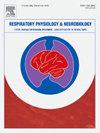潮末二氧化碳和通风:评估优秀长跑运动员表现水平的新指标。
IF 1.6
4区 医学
Q3 PHYSIOLOGY
引用次数: 0
摘要
在给定的工作速率下,训练良好的个体比训练不佳的个体表现出更低的分钟通气量(V (E))和更高的CO2末潮分压(PETCO2)。这项研究调查了在训练有素的人身上看到的这种呼吸适应是否也适用于优秀的长跑运动员。41名长跑运动员根据成绩分为高水平组(Long-High,由东京箱根大学马拉松接力选手和奥运会运动员组成,n=23)和低水平组(Long-Low, n=18)。10名中长跑运动员(Middle)也参加了一个对照组。所有受试者在电动跑步机上进行增量运动测试,直到精疲力竭。长组的最大V / O2和速度大于中组,但这些指标在长高组和长低组之间没有区别。相比之下,V (E)和PETCO2能够识别Long-High组。长-高组的次最大V / E最低,而PETCO2在高跑速时最高。本研究证实,低V / E和高PETCO2的呼吸模式是评估优秀长跑运动员耐力赛表现的相关适应指标。本文章由计算机程序翻译,如有差异,请以英文原文为准。
End-tidal CO2 and ventilation: Novel markers for assessing performance levels in elite long-distance runners
Well-trained individuals, compared to less well-trained individuals, exhibit a lower minute ventilation (V̇E) and higher end-tidal partial pressure of CO2 (PETCO2) at a given work rate. This study investigated whether such breathing adaptations seen in well-trained individuals also applied to elite long-distance runners. Forty-one long-distance runners were categorized into high (Long-High, consisting of Tokyo-Hakone College Ekiden [relay marathon] runners and Olympic athletes, n = 23), or low performance-level group (Long-Low, n = 18) according to their race times. Ten middle-distance runners (Middle) also participated in a comparison group. All subjects performed an incremental exercise test on a motorized treadmill until exhaustion. Maximum V̇O2 and velocity were greater for the Long groups than the Middle group, however these measures were not distinguishable between the Long-High and the Long-Low groups. By contrast, V̇E and PETCO2 were able to identify the Long-High group. Submaximal V̇E were lowest, whilst PETCO2 especially at high running velocities were highest for the Long-High group. This study confirms that breathing patterns with lower V̇E and higher PETCO2 are relevant adaptation markers for assessing endurance race performance in elite long-distance runners.
求助全文
通过发布文献求助,成功后即可免费获取论文全文。
去求助
来源期刊
CiteScore
4.80
自引率
8.70%
发文量
104
审稿时长
54 days
期刊介绍:
Respiratory Physiology & Neurobiology (RESPNB) publishes original articles and invited reviews concerning physiology and pathophysiology of respiration in its broadest sense.
Although a special focus is on topics in neurobiology, high quality papers in respiratory molecular and cellular biology are also welcome, as are high-quality papers in traditional areas, such as:
-Mechanics of breathing-
Gas exchange and acid-base balance-
Respiration at rest and exercise-
Respiration in unusual conditions, like high or low pressure or changes of temperature, low ambient oxygen-
Embryonic and adult respiration-
Comparative respiratory physiology.
Papers on clinical aspects, original methods, as well as theoretical papers are also considered as long as they foster the understanding of respiratory physiology and pathophysiology.

 求助内容:
求助内容: 应助结果提醒方式:
应助结果提醒方式:


